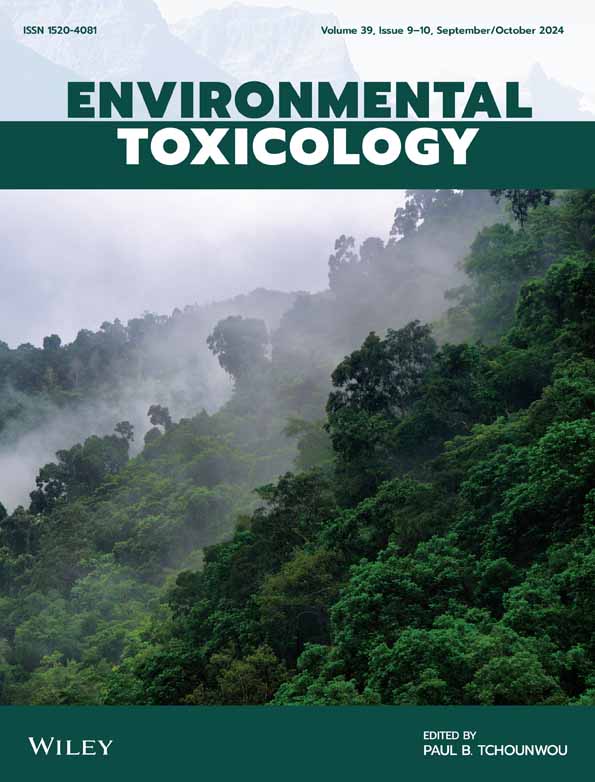结合氧化应激和组织学生物标志物作为17- α -乙炔雌醇暴露的指标。
IF 3.2
3区 医学
Q2 ENVIRONMENTAL SCIENCES
引用次数: 0
摘要
采用生理指标(肝体指数、脾体指数、红细胞压积)、氧化应激(过氧化氢酶、谷胱甘肽过氧化物酶和谷胱甘肽还原酶活性)评价17- α -乙炔雌二醇(50、100和500 μg EE2/kg b.w,连续30 d)对田鼠(Tinca Tinca)的潜在不良影响;总谷胱甘肽水平和脂质过氧化),代谢(谷胱甘肽s -转移酶活性)以及组织病理学(描述性和分析性研究)反应。在高剂量下,ee2暴露个体的躯体指标增加,并出现贫血,从而影响了暴露个体的总体健康状况。由于脂质过氧化过程不相关,暴露于EE2的海胆的抗氧化防御系统对活性氧的有效控制应该已经发生。组织病理学研究显示,暴露的鱼肝脏出现退行性变化(空泡变性和嗜酸性物质沉积),脾脏出现退行性变化(嗜酸性物质沉积)和进行性变化(网状内皮细胞增生)。一些病变的严重程度是剂量依赖性的。发现的损伤并没有损害这些器官的功能。最后,在目前的研究中,氧化应激参数和形态学变化之间没有发现共同的相关模式。本文章由计算机程序翻译,如有差异,请以英文原文为准。
Integrated Use of Oxidative Stress and Histological Biomarkers of T. tinca as Indicators of 17-Alpha-Ethynylestradiol Exposure.
The potential adverse effects of 17-alpha-ethynylestradiol (50, 100, and 500 μg EE2/kg b.w., for 30 days) on tench (Tinca tinca) were evaluated by integrating biomarkers including physiological (hepato-somatic index, spleen-somatic index, and hematocrit), oxidative stress (catalase, glutathione peroxidase, and glutathione reductase activities; total glutathione level, and lipid peroxidation), metabolic (glutathione S-transferase activity), as well as histopathological (descriptive and analytical studies) responses. The general health status of the EE2-exposed tench was disturbed based on the increase of somatic indices at high tested doses, and the development of anemia in all exposed individuals. Effective control of reactive oxygen species by the antioxidant defense system of the tench exposed to EE2 should have occurred because the lipid peroxidation process was irrelevant. Histopathological study revealed the presence of regressive changes in the liver (vacuolar degeneration, and deposits of eosinophilic material), regressive (deposits of eosinophilic material), and progressive (hyperplasia of reticuloendothelial cells) changes in the spleens of exposed fish. The severity of some lesions was dose dependent. The identified injuries did not compromise the functions of these organs. Finally, a common pattern of correlation between parameters of oxidative stress and morphological changes was not detected in the current study.
求助全文
通过发布文献求助,成功后即可免费获取论文全文。
去求助
来源期刊

Environmental Toxicology
环境科学-毒理学
CiteScore
7.10
自引率
8.90%
发文量
261
审稿时长
4.5 months
期刊介绍:
The journal publishes in the areas of toxicity and toxicology of environmental pollutants in air, dust, sediment, soil and water, and natural toxins in the environment.Of particular interest are:
Toxic or biologically disruptive impacts of anthropogenic chemicals such as pharmaceuticals, industrial organics, agricultural chemicals, and by-products such as chlorinated compounds from water disinfection and waste incineration;
Natural toxins and their impacts;
Biotransformation and metabolism of toxigenic compounds, food chains for toxin accumulation or biodegradation;
Assays of toxicity, endocrine disruption, mutagenicity, carcinogenicity, ecosystem impact and health hazard;
Environmental and public health risk assessment, environmental guidelines, environmental policy for toxicants.
 求助内容:
求助内容: 应助结果提醒方式:
应助结果提醒方式:


